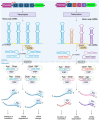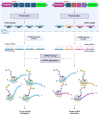Therapeutic Applications of Poly-miRNAs and miRNA Sponges
- PMID: 40429680
- PMCID: PMC12111552
- DOI: 10.3390/ijms26104535
Therapeutic Applications of Poly-miRNAs and miRNA Sponges
Abstract
MicroRNAs (miRNAs) are small, non-coding RNA molecules that play crucial roles in regulating gene expression, and their dysregulation is implicated in various human diseases. Over the years, several research groups have identified miRNAs as promising therapeutic targets for intervention. Therapeutic strategies involve either overexpression or knockdown of specific miRNAs. This review aims to provide a comprehensive overview of synthetic poly-miRNAs and miRNA sponges, highlighting their therapeutic applications. It begins with an introduction to miRNAs and their role in human diseases, followed by a detailed discussion on synthetic poly-miRNAs and miRNA sponges by exploring their application in cardiovascular, inflammatory, autoimmune, and metabolic disorders, as well as in cancer therapy. Additionally, strategies for targeted delivery, challenges, and limitations of these therapies are addressed.
Keywords: RNA-based therapy; biomedicine; miRNA; miRNA sponge; poly-miRNA.
Conflict of interest statement
The authors declare no conflicts of interest.
Figures


Similar articles
-
Using artificial microRNA sponges to achieve microRNA loss-of-function in cancer cells.Adv Drug Deliv Rev. 2015 Jan;81:117-27. doi: 10.1016/j.addr.2014.05.010. Epub 2014 May 22. Adv Drug Deliv Rev. 2015. PMID: 24859534 Review.
-
miRNA sponges: soaking up miRNAs for regulation of gene expression.Wiley Interdiscip Rev RNA. 2014 May-Jun;5(3):317-33. doi: 10.1002/wrna.1213. Epub 2013 Dec 23. Wiley Interdiscip Rev RNA. 2014. PMID: 24375960 Review.
-
Advancing miRNA cancer research through artificial intelligence: from biomarker discovery to therapeutic targeting.Med Oncol. 2024 Dec 17;42(1):30. doi: 10.1007/s12032-024-02579-z. Med Oncol. 2024. PMID: 39688780 Review.
-
miRNA and cancer; computational and experimental approaches.Curr Pharm Biotechnol. 2014;15(5):429. doi: 10.2174/138920101505140828161335. Curr Pharm Biotechnol. 2014. PMID: 25189575
-
Role of miRNA sponges in hepatocellular carcinoma.Clin Chim Acta. 2020 Jan;500:10-19. doi: 10.1016/j.cca.2019.09.013. Epub 2019 Oct 8. Clin Chim Acta. 2020. PMID: 31604064 Review.
References
-
- Fu Y., Chen J., Huang Z. Recent Progress in microRNA-Based Delivery Systems for the Treatment of Human Disease. ExRNA. 2019;1:24. doi: 10.1186/s41544-019-0024-y. - DOI
-
- Vishnoi A., Rani S. miRNA Biogenesis and Regulation of Diseases: An Updated Overview. In: Rani S., editor. MicroRNA Profiling: Methods and Protocols. Springer; New York, NY, USA: 2023. pp. 1–12. - PubMed
Publication types
MeSH terms
Substances
Grants and funding
LinkOut - more resources
Full Text Sources

